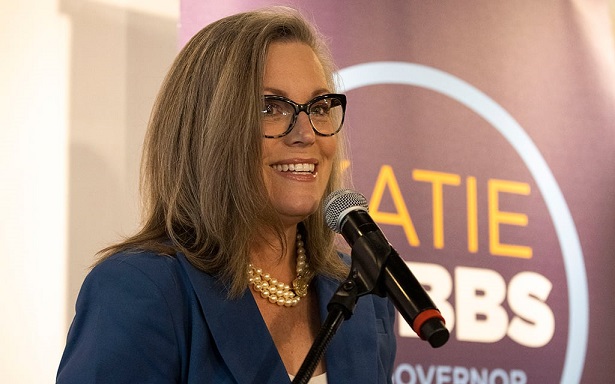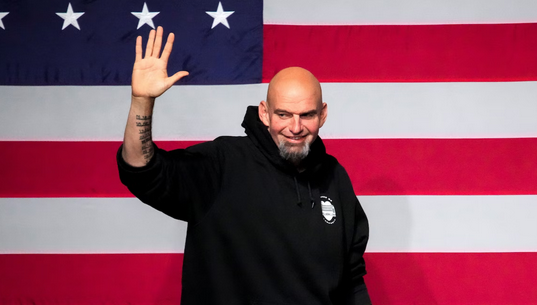How President Biden Helped Democrats Avert A Midterm Disaster!
Yahoo.com, By Alexander Nazaryan·Senior White House Correspondent, Posted November 22nd 2022
As the midterm elections approached, a “red wave” of Republican victories appeared to be building on the horizon, potentially handing the party both chambers of Congress and key governorships in states like Arizona and New York.
At least that’s what the headlines promised.
“‘A Category 2 or 3 Hurricane Headed Democrats’ Way,’” warned New York magazine, basing its prediction on the analysis of a respected pollster, Dave Wasserman of the Cook Political Report.
“Red tsunami watch,” Axios declared on Oct. 23, predicting that Republican gains would be so large, the GOP would potentially enjoy a 20-seat majority in the House of Representatives.
All this, the received wisdom went, would all amount to a humiliating rebuke of President Biden — and that surveying the devastation on the political battlefield, the president was bound to declare that he would not seek reelection in 2024.
It never happened. As things stand, Democrats could potentially expand their Senate majority, depending on how Georgia’s runoff election between Sen. Raphael Warnock and the former football star Herschel Walker unfolds next month. But even if Warnock loses, the chamber will remain blue.
The lower chamber did turn red, but only barely so, while Democrats won important gubernatorial races in Arizona, New York, Pennsylvania and Oregon, in what could be auspicious signs for the party’s agenda.
“It was a good day for America,” President Biden said at a press conference after Election Day.
The Democratic victories were tinged with disappointing defeats: of Reps. Sean Patrick Maloney of New York and Tom Malinowski of New Jersey, both seemingly safe incumbents; Wisconsin Lt. Gov. Mandela Barnes, a promising young Senate candidate; Rep. Tim Ryan in Ohio, where he was running for the Senate. Nevertheless, it was still the most favorable outcome for a first-term president facing his first midterm election in at least two decades, meaning that Biden could celebrate an achievement denied both to his predecessor Donald Trump, who raged at losing the House in 2018, and to his former boss, Barack Obama, the recipient of what he famously described as a “shellacking” in 2010.
For a White House pummeled from all sides for its handling of the midterms, the results were a resounding validation of its decision to focus tightly on abortion access and election denialism. “Voters are smarter than the media,” White House chief of staff Ron Klain told Vanity Fair in an interview earlier this week.
Now, Democrats are expected to use the same argument against the GOP House majority and Republicans announcing presidential runs of their own. Trump made his own announcement to that effect earlier this week, only to be met with a barrage of Democratic countermessaging indicating that the White House believes it has discovered a successful formula that will work beyond 2022.

Just how much credit Biden deserves is a matter of dispute. Could he have done more? Should he have done less? Is it possible that he did just about enough? “I don’t think Biden was a big factor in this election,” the veteran Democratic strategist James Carville has argued.
Which, the president’s aides and allies say, was precisely the point.
In conversation with Yahoo News, White House advisers say that, with Republicans’ inadvertent help, Biden managed to redirect focus away from himself, toward what he described as a party increasingly beholden to a far-right ideology that most Americans do not endorse. “Americans rejected extreme candidates across the country, up and down the ball,” one adviser told Yahoo News, depicting the election as a vindication of both of Biden’s political approach and of his economic agenda, which has included trillions in new federal spending.
“It’s clear that Americans want normalcy,” the adviser said, speaking on the condition of anonymity.
The president stuck to his message even as pundits complained that he was not doing enough to address public concerns about inflation and public safety. “Democrats need to understand that we have a winning message on the economy and inflation,” four leading Democrats wrote in the American Prospect. “But rising costs will beat us if we avoid the issue.”
Although he gave a number of speeches on the economy, and gun violence, Biden mostly emphasized the broad divide between Democrats and Republicans, which he said amounted to a choice between democracy and its demise.
“He went out and defined the choice, with the party second-guessing him all the time,” a senior Biden adviser, Anita Dunn, told Yahoo News in an interview.
Never was the disconnect between Biden and other Democrats — congressional candidates, consultants, pundits — more apparent than on the Wednesday before Election Day, when he delivered a speech on democracy from D.C.’s Union Station, whose decrepit interior has hardly been a beacon of inspiration since the start of the pandemic. Biden spoke of the Jan. 6, 2021, riot at the U.S. Capitol, only a short walk away, and of the previous week’s attack on House Speaker Nancy Pelosi’s husband in San Francisco, which advisers say deeply rattled him.
He had been espousing his faith in democracy from the moment he announced his run for the presidency in 2019; now, with his party possibly on the cusp of a major setback and his own political fortunes plummeting, he wanted to celebrate democracy and democratic institutions one more time before polling sites opened.
As he had been doing for months, he denounced the so-called MAGA Republicans — the acronym, for Make America Great Again, is from Donald Trump’s 2016 presidential run — who, he said, were endangering abortion rights and electoral integrity.
“The fate of the nation, the fate of the soul of America, lies where it always does — with the people, in your hands, in your heart, in your ballot,” Biden said.

Pundits were not impressed. “Issues of democracy are hugely important at this moment and in next week’s election,” the Democratic strategist David Axelrod, architect of Barack Obama’s successful 2008 presidential run, wrote on Twitter before the speech. “Totally appropriate for @POTUS to address them. Still, as a matter of practical politics, I doubt many Ds in marginal races are eager for him to be on TV tonight.”
But by the following Tuesday, most of the nation’s most prominent election deniers, including Senate candidate Don Bolduc of New Hampshire and gubernatorial candidate Kari Lake of Arizona, were headed for defeat. Meanwhile, many of the Democrats who had campaigned on abortion and democracy managed to prevail in races across the country.
He put MAGA extremism on the ballot,” says Navin Nayak, who directs the political arm of the Center for American Progress, a Washington think tank closely aligned with the Biden administration.
Nayak argued that between the Supreme Court’s decision last spring in Dobbs v. Jackson Women’s Health Organization, which allowed states to regulate abortion, and the summer’s congressional hearings into the Jan. 6 riot — which were praised for both their substance and their TV-ready production values — Biden could legitimately claim that the choice was not between two political parties but between a political party and an emboldened conservative minority held together by its fealty to a single man, the defeated former president.
That Trump was widely expected to announce a third presidential run only made the argument more vivid. (Trump announced his run on Tuesday evening from his South Florida golf club, Mar-a-Lago.)
“This wasn’t a manufactured political strategy,” Nayak told Yahoo News in a telephone interview. “It was real, and it was scary.”
Biden first deployed a version of the MAGA label (it has several variations) in a White House speech after a leaked Supreme Court opinion indicated that the increasingly conservative bench would use Dobbs to strike down Roe v. Wade, the 1973 ruling that made abortion legal.
Democrats had been testing the phrase for months. They found that, when presented to voters, it invoked the one figure who remained the Democrats’ greatest motivator: Trump. Here were three conservative justices appointed by Trump, prepared to strip women of reproductive choice. And there, testifying before the Jan. 6 committee, were former Trump aides describing in cinematic detail his desire to subvert the results of the 2020 presidential election.
For the president and his advisers, something far more significant than just policy differences was afoot. “We’re going to make a contrast to the American people,” Biden pollster John Anzalone told Yahoo News in May.
For much of 2022 the mood was sour, with Americans consistently telling pollsters that they believed the country was headed in the wrong direction. Inflation was bad, and so was gun violence, with several mass shootings throughout the spring and summer. The coronavirus was still killing hundreds of people daily. War in Eastern Europe and lockdowns in China were causing economic uncertainty.

Biden was blamed for all this and more — sometimes fairly and sometimes not. But he insisted that even if his plans were not yet fully realized, at least there were plans to speak of. The only plans Republicans had, he argued, involved taking away rights and benefits Americans had enjoyed for generations.
That argument was often helped along by Republicans, as when Sen. Rick Scott, R-Fla., who led the party’s Senate reelection effort, introduced an economic proposal that would cut taxes while forcing Congress to regularly renew extremely popular social programs like Social Security. The White House quickly seized on Scott’s plan, turning it into another pillar of a makeshift MAGA agenda, conveniently ignoring the fact that the proposal had been denounced by Sen. Mitch McConnell, the GOP leader in the Senate, and others in the party.
“MAGA came with highly charged emotional negatives,” Dunn says, arguing that his regular deployment of the phrase was a branding success. “He does not get enough credit for that. That was critical.”
Summer saw the passage of the Inflation Reduction Act, which devoted $369 billion to climate change initiatives, by far the biggest such investment in American history. Congress also passed the CHIPs Act, a $50 billion bid to revive the nation’s anemic semiconductor production industry.
But as with the $1.9 trillion infrastructure bill Congress had passed the year before, these enormous outlays would move slowly through the federal bureaucracy, far too slowly to make a difference in the midterms. So even as Biden touted his own successes, and urged other Democrats to do the same, those accomplishments felt abstract, while Fox News reports about violent crime and soaring gas prices (which had dipped in the summer, only to rise again in the fall) felt like pressing concerns.
Democratic prospects were helped on Sept. 13, a singularly odd day that, in many ways, offers a microcosm of the dynamics of the midterms. That morning, Sen. Lindsey Graham, R-S.C., held a Capitol Hill press conference to announce that if Republicans won both chambers of Congress, he would introduce a national ban on abortion.
His widely covered proposal, which caught even McConnell by surprise, instantly energized Democrats, who might otherwise have been forced to confront discouraging consumer price figures that had been released that morning. To make matters worse, Biden was scheduled to celebrate the Inflation Reduction Act at a White House event that afternoon, making for a potentially awkward juxtaposition.
Instead of inflation, abortion dominated the news, with Graham offering a reminder that the consequences of the Dobbsdecision would continue to reverberate through American society. After all, in his concurring opinion, Justice Clarence Thomas all but invited conservatives to challenge other so-called unenumerated rights that Americans had come to take for granted, including the right to same-sex marriage and access to contraception. Those were not part of Graham’s proposed bill, but the mere prospect of a national ban seemed to remind voters of what was at stake in November.
“What Dobbs did was validate in real time, in real life, how extreme the other side was,” Dunn told Yahoo News.
Even as Washington and the rest of the nation continued to ponder Graham’s proposal, Sen. Scott showed up in front of the White House to tout his economic plan, presenting a giddy West Wing with another opportunity to brand the GOP as a party unabashedly opposed to popular programs and personal freedoms.
At the same time, Democrats were boosting some more extreme MAGA Republicans, in the hope that far-right candidates who won a GOP primary might lose their footing in a general election. Several of those candidates won their September primaries.

Still, by October, Democratic enthusiasm had cooled off. Outrage over Dobbs appeared to wane, and the Jan. 6 hearings concluded. Republicans sharpened their attacks on public safety, using high-profile crimes in New York and elsewhere to associate Democrats with unpopular messages like defunding police departments. The attacks were exaggerated and relentless. And they seemed to work.
So, the narrative turned again, at least on cable television and social media. Biden was criticized for not campaigning aggressively enough, or not campaigning on the right issues. Or, given his own unpopularity, for not staying home. “Biden is viewed as a drag on Democratic midterm hopes,” read a headline in The Hill.
Such reports were treated with suspicion inside the White House. Biden does not call journalists “enemies of the people,” as Trump does, but he and his top aides are frequently frustrated by coverage that, they believe, does not give him enough due. They’re still smarting from the veritable cavalcade of articles from 2019 and early 2020 about how Biden was too old, moderate and out of touch to win a Democratic primary.
Early reports of a red wave were met with similar skepticism throughout October. “It’s just a stupid construct that the polls have created, that the media have latched on to, that has led everyone astray,” Nayak of the Center for American Progress argued.
Biden seemed oddly unperturbed, landing in Maryland for his last campaign stop, on the eve of Election Day, where a Democratic gubernatorial candidate, Wes Moore, was running against election denier Dan Cox, a pro-Trump Republican.
Moore’s victory the following evening was hardly a surprise, but John Fetterman’s win over Dr. Mehmet Oz, another Trump-endorsed candidate, for a U.S. Senate seat from Pennsylvania suddenly gave Democrats hope for the rest of the evening.
There were plenty of disappointments, to be sure, including the House losses by Malinowski and Maloney. Stacey Abrams in Georgia and Beto O’Rourke in Texas both lost their gubernatorial contests, dimming the hopes of two of the party’s brighter young stars. Senate races in North Carolina and Florida went to the Republicans.
Still, the results were nowhere near the disaster that had been predicted. If anything, they validated Biden’s approach. In Arizona, for example, an entire slate of election deniers lost. And in all five states with abortion-related referenda, voters cast ballots in favor of more reproductive choice, not less.
Nothing may have been quite as helpful as Biden’s effort to make the election not about himself but about Trump. “President Trump loomed large over these midterm elections, and in some ways, the midterms were as much about the former president’s influence on Republican candidates as they were about Joe Biden’s first two years in office,” Stanford political scientist Didi Kuo said in a post-election analysis.
A relieved White House sees Democrats’ partial victory as a kind of proof-of-concept, evidence that the reductive arguments of pollsters and pundits do not hold up in the real world.
“What is clear and what we’ve known is that voters bring their whole selves to the polls,” another Biden adviser told Yahoo News. “Americans care about lowering costs while also caring about issues like access to abortion and reproductive care. It was a false choice to indicate otherwise.”








